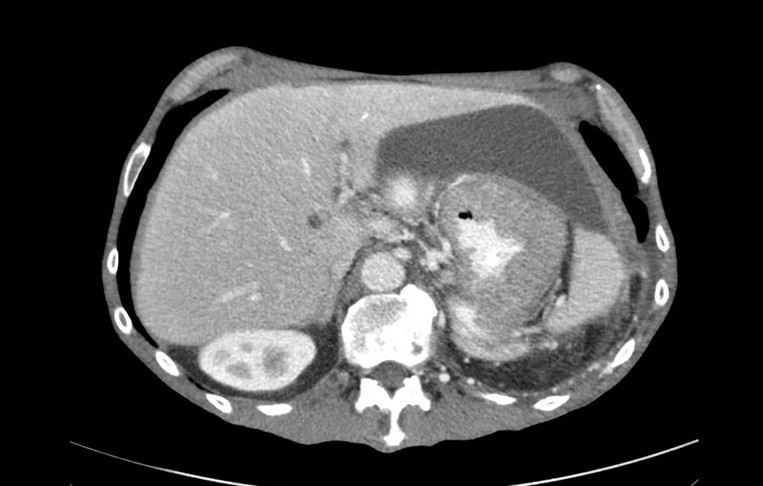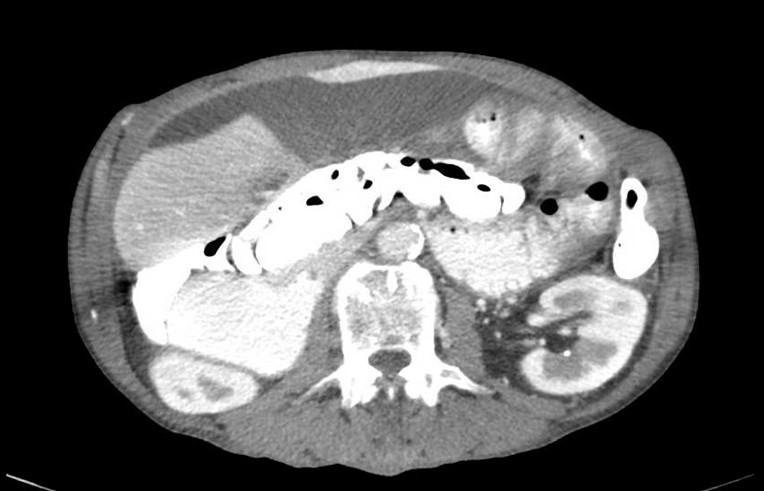Monday Poster Session
Category: Stomach and Spleen
P4250 - At a Distance from the Mucosa: Diagnostic Pitfalls in Advanced Gastric Linitis Plastica Presenting as SMA Syndrome and Hepatic Lesions
Monday, October 27, 2025
10:30 AM - 4:00 PM PDT
Location: Exhibit Hall

Jose A. Benitez, MD
University of Texas Health San Antonio
San Antonio, TX
Presenting Author(s)
Jose Benitez, MD, Jose I.. De Arrigunaga, DO
University of Texas Health San Antonio, San Antonio, TX
Introduction: Signet ring cell carcinoma (SRCC) is an aggressive and rare form of gastric cancer that originates from gastric glandular cells with abundant mucin displacing nuclei, resulting in characteristic appearing “signet ring cells”. This cancer usually presents at more advanced stages and are notoriously invasive with poor differentiation and multiple complications. We present a case of a patient with unexplained weight loss and superior mesenteric artery syndrome revealing underlying advanced gastric cancer with signet ring cell features.
Case Description/
Methods: A 55-year-old male with past medical history of chronic liver disease secondary to alcohol use disorder presented for intractable nausea and vomiting. The patient also experienced unintentional weight loss of 50 lbs in five months and early satiety. Abdominal imaging revealed distended stomach and duodenum with transition point at superior mesenteric artery (SMA) consistent with SMA syndrome (Figure 1). Multiple hepatic parenchymal lesions were seen so liver biopsy was obtained which revealed metastatic poorly differentiated carcinoma with signet-ring cell features. EGD was performed which revealed enlarged and congested gastric folds with submucosal infiltrative diffuse gastric cancer (linitis plastica) (Figure 2). Multiple gastric biopsies were interestingly negative for metaplasia or malignancy, however due to unequivocal imaging, clinical, and endoscopic evidence, the patient was diagnosed with metastatic stage IV gastric carcinoma with signet ring cell features. The patient would undergo repeat biopsy with next generation sequencing for outpatient chemotherapy.
Discussion: This case highlights the diagnostic complexities of advanced gastric linitis plastica with signet ring cell features presenting initially as superior mesenteric artery syndrome and undifferentiated hepatic lesions. The diagnostic ambiguity with advanced gastric cancer is illustrated here given multiple negative biopsies yet profound imaging and endoscopic evidence of advanced cancer. False negative biopsies have been well documented in advanced gastric carcinomas given malignant cells are typically found in deeper stomach tissue, hence the NCCN diagnostic recommendation of utilizing all endoscopic, radiologic, histopathological, and clinical evidence when gastric cancer is suspected, especially with equivocal biopsy results.

Figure: Figure 1: Diffuse thickening of gastric mucosa demonstrated highly suspicious of linitis plastica pathology

Figure: Figure 2: Dilation of the distal stomach and proximal duodenum seen with transition at the origin of SMA, consistent with SMA syndrome
Disclosures:
Jose Benitez indicated no relevant financial relationships.
Jose De Arrigunaga indicated no relevant financial relationships.
Jose Benitez, MD, Jose I.. De Arrigunaga, DO. P4250 - At a Distance from the Mucosa: Diagnostic Pitfalls in Advanced Gastric Linitis Plastica Presenting as SMA Syndrome and Hepatic Lesions, ACG 2025 Annual Scientific Meeting Abstracts. Phoenix, AZ: American College of Gastroenterology.
University of Texas Health San Antonio, San Antonio, TX
Introduction: Signet ring cell carcinoma (SRCC) is an aggressive and rare form of gastric cancer that originates from gastric glandular cells with abundant mucin displacing nuclei, resulting in characteristic appearing “signet ring cells”. This cancer usually presents at more advanced stages and are notoriously invasive with poor differentiation and multiple complications. We present a case of a patient with unexplained weight loss and superior mesenteric artery syndrome revealing underlying advanced gastric cancer with signet ring cell features.
Case Description/
Methods: A 55-year-old male with past medical history of chronic liver disease secondary to alcohol use disorder presented for intractable nausea and vomiting. The patient also experienced unintentional weight loss of 50 lbs in five months and early satiety. Abdominal imaging revealed distended stomach and duodenum with transition point at superior mesenteric artery (SMA) consistent with SMA syndrome (Figure 1). Multiple hepatic parenchymal lesions were seen so liver biopsy was obtained which revealed metastatic poorly differentiated carcinoma with signet-ring cell features. EGD was performed which revealed enlarged and congested gastric folds with submucosal infiltrative diffuse gastric cancer (linitis plastica) (Figure 2). Multiple gastric biopsies were interestingly negative for metaplasia or malignancy, however due to unequivocal imaging, clinical, and endoscopic evidence, the patient was diagnosed with metastatic stage IV gastric carcinoma with signet ring cell features. The patient would undergo repeat biopsy with next generation sequencing for outpatient chemotherapy.
Discussion: This case highlights the diagnostic complexities of advanced gastric linitis plastica with signet ring cell features presenting initially as superior mesenteric artery syndrome and undifferentiated hepatic lesions. The diagnostic ambiguity with advanced gastric cancer is illustrated here given multiple negative biopsies yet profound imaging and endoscopic evidence of advanced cancer. False negative biopsies have been well documented in advanced gastric carcinomas given malignant cells are typically found in deeper stomach tissue, hence the NCCN diagnostic recommendation of utilizing all endoscopic, radiologic, histopathological, and clinical evidence when gastric cancer is suspected, especially with equivocal biopsy results.

Figure: Figure 1: Diffuse thickening of gastric mucosa demonstrated highly suspicious of linitis plastica pathology

Figure: Figure 2: Dilation of the distal stomach and proximal duodenum seen with transition at the origin of SMA, consistent with SMA syndrome
Disclosures:
Jose Benitez indicated no relevant financial relationships.
Jose De Arrigunaga indicated no relevant financial relationships.
Jose Benitez, MD, Jose I.. De Arrigunaga, DO. P4250 - At a Distance from the Mucosa: Diagnostic Pitfalls in Advanced Gastric Linitis Plastica Presenting as SMA Syndrome and Hepatic Lesions, ACG 2025 Annual Scientific Meeting Abstracts. Phoenix, AZ: American College of Gastroenterology.
